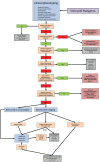Novel therapeutics in nystagmus: what has the genetics taught us so far?
- PMID: 37181109
- PMCID: PMC10032456
- DOI: 10.1177/2633004021998714
Novel therapeutics in nystagmus: what has the genetics taught us so far?
Abstract
Nystagmus is a disorder characterised by uncontrolled, repetitive, to-and-fro movement of the eyes. It can occur as a seemingly isolated disorder but is most commonly the first, or most obvious, feature in a host of ophthalmic and systemic disorders. The number of underlying causes is vast, and recent improvements in the provision of genetic testing have shown that many conditions can include nystagmus as a feature, but that phenotypes overlap significantly. Therefore, an increase in the understanding of the genetic causes of nystagmus has shown that successful novel therapeutics for 'nystagmus' can target either specific underlying disorders and mechanisms (aiming to treat the underlying condition as a whole), or a final common pathway (aiming to treat the nystagmus directly).
Plain language summary: Novel treatments for a disorder of eye movement (nystagmus): what has the genetics taught us so far? Nystagmus is a disorder of eye movement characterised by uncontrolled, to-and-fro movements. It can occur as an isolated disorder, in conditions affecting other parts of the eye, in conditions affecting multiple other parts of the body or secondary to neurological diseases (brain diseases). In recent years, advances in genetic testing methods and increase in genetic testing in healthcare systems have provided a greater understanding of the underlying causes of nystagmus. They have highlighted the bewildering number of genetic causes that can result in what looks like a very similar eye movement disorder.In recent years, new classes of drugs have been developed for some of the causes of nystagmus, and some new drugs have been developed for other conditions which have the potential to work in certain types of nystagmus. For these reasons, genetics has taught us that identifying new possible treatments for nystagmus can either be dependent on identifying the underlying genetic cause and aiming to treat that, or aiming to treat the nystagmus per se by targeting a final common pathway. A toolkit based on specific treatments for specific conditions is more to have meaningful impact on 'nystagmus' than pursuing a panacea based on a 'one size fits all' approach.
Keywords: albinism therapy; novel therapeutics; nystagmus.
© The Author(s), 2021.
Conflict of interest statement
The authors declare that there is no conflict of interest.
Figures

References
-
- Abel LA. Infantile nystagmus: current concepts in diagnosis and management. Clin Exp Optom 2006; 89: 57–65. - PubMed
-
- Sarvananthan N, Surendran M, Roberts EO, et al. The prevalence of nystagmus: the Leicestershire nystagmus survey. Invest Ophthalmol Vis Sci 2009; 50: 5201–5206. - PubMed
-
- CEMAS Workshop. Classification of Eye Movement Abnormalities and Strabismus (CEMAS) Workshop report. National Eye Institute Sponsored Workshop; 2001.
Publication types
Grants and funding
LinkOut - more resources
Full Text Sources
